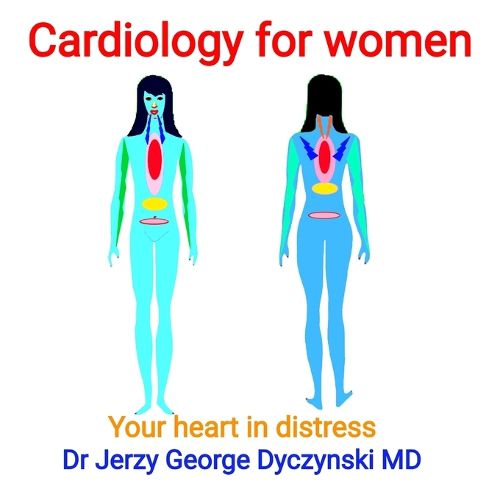Readings Newsletter
Become a Readings Member to make your shopping experience even easier.
Sign in or sign up for free!
You’re not far away from qualifying for FREE standard shipping within Australia
You’ve qualified for FREE standard shipping within Australia
The cart is loading…






This title is printed to order. This book may have been self-published. If so, we cannot guarantee the quality of the content. In the main most books will have gone through the editing process however some may not. We therefore suggest that you be aware of this before ordering this book. If in doubt check either the author or publisher’s details as we are unable to accept any returns unless they are faulty. Please contact us if you have any questions.
Women's hearts, distinct in size, structure, function, and emotion processing, face unique challenges in cardiovascular health. The term angina pectoris is derived from the Latin angere and' pectus. It translates to a strangling feeling in the chest, describing the symptom of coronary artery narrowing. Women, with their bodies designed for beauty, comfort, and acts of charity, are more susceptible to stress and pain than men due to the presence of internal reproductive female organs and the influence of feminine hormones. The distress impacts a woman's heart, exponentially causing multiple spasms in the arteries of the coronary arteries and putting part of the heart in hibernation, making the heart muscle weak. It can potentially lead to a heart in distress. This shows the need for a holistic approach to women's cardiovascular care, addressing the physical, emotional, and soul aspects.
Angina pectoris, a symptom of coronary artery narrowing, can manifest uniquely in women, often in the lower abdomen. This can be felt as pain, pressure, tightness, or discomfort in the lower abdomen. The pain may radiate to the back, hips, or thighs, worsening with exertion or stress and improving with rest, a key to recognizing heart distress beyond the veil hiding it.
Women are known for their warmth, tenderness in the heart, and love, which they express through affectionate gestures. These unique characteristics have facilitated the development of Cardiology for women, as heart changes progress differently in women than in men.
Stress, a common factor in modern life, can profoundly impact your body, including the heart, brain, and pelvic floor muscles. Muscle tension in the pelvic area can activate the pelvic stress reflex, causing pain and discomfort in the pelvis area and the uterus. This makes it more challenging for women to manage stress and maintain integrity under stressful circumstances. The pelvic stress reflex can influence your breathing very strongly, and pelvic pain contributes to the raising of the heart in distress, underscoring the need to address feminine stress in a way of holistic heart health.
$9.00 standard shipping within Australia
FREE standard shipping within Australia for orders over $100.00
Express & International shipping calculated at checkout
This title is printed to order. This book may have been self-published. If so, we cannot guarantee the quality of the content. In the main most books will have gone through the editing process however some may not. We therefore suggest that you be aware of this before ordering this book. If in doubt check either the author or publisher’s details as we are unable to accept any returns unless they are faulty. Please contact us if you have any questions.
Women's hearts, distinct in size, structure, function, and emotion processing, face unique challenges in cardiovascular health. The term angina pectoris is derived from the Latin angere and' pectus. It translates to a strangling feeling in the chest, describing the symptom of coronary artery narrowing. Women, with their bodies designed for beauty, comfort, and acts of charity, are more susceptible to stress and pain than men due to the presence of internal reproductive female organs and the influence of feminine hormones. The distress impacts a woman's heart, exponentially causing multiple spasms in the arteries of the coronary arteries and putting part of the heart in hibernation, making the heart muscle weak. It can potentially lead to a heart in distress. This shows the need for a holistic approach to women's cardiovascular care, addressing the physical, emotional, and soul aspects.
Angina pectoris, a symptom of coronary artery narrowing, can manifest uniquely in women, often in the lower abdomen. This can be felt as pain, pressure, tightness, or discomfort in the lower abdomen. The pain may radiate to the back, hips, or thighs, worsening with exertion or stress and improving with rest, a key to recognizing heart distress beyond the veil hiding it.
Women are known for their warmth, tenderness in the heart, and love, which they express through affectionate gestures. These unique characteristics have facilitated the development of Cardiology for women, as heart changes progress differently in women than in men.
Stress, a common factor in modern life, can profoundly impact your body, including the heart, brain, and pelvic floor muscles. Muscle tension in the pelvic area can activate the pelvic stress reflex, causing pain and discomfort in the pelvis area and the uterus. This makes it more challenging for women to manage stress and maintain integrity under stressful circumstances. The pelvic stress reflex can influence your breathing very strongly, and pelvic pain contributes to the raising of the heart in distress, underscoring the need to address feminine stress in a way of holistic heart health.